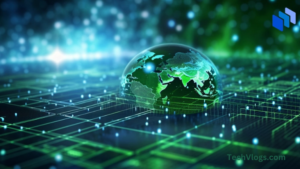Internet of Things
The Internet of Things (IOT) is revolutionizing the way the world operates by creating a vast network of interconnected devices. These devices, ranging from everyday household items to complex industrial machinery, are equipped with sensors and software that enable them to communicate and share data. This seamless integration allows for enhanced automation, improved efficiency, and smarter decision-making across various sectors. IoT is driving innovation in healthcare, transportation, agriculture, and smart cities, transforming how we live and work. As IoT continues to evolve, it promises to unlock new opportunities and challenges, shaping the future of technology and connectivity.

Smart Devices Everywhere:
Imagine a world brimming with smart devices—thermostats that adjust automatically, refrigerators that order groceries, and fitness trackers that monitor your health. These interconnected devices, the backbone of the IoT, gather and exchange data, creating a network of intelligent systems.
Home Automation on the Rise:
Forget manually adjusting lights or turning on appliances. IoT empowers homes with automation. Smart speakers let you control devices with your voice, while connected thermostats optimize energy use, creating a more comfortable and efficient living space.
Industrial IoT Boosts Efficiency:
Factories are no strangers to IoT either. Industrial IoT (IoT) connects machines, sensors, and production lines, enabling real-time monitoring and data analysis. This translates to optimized processes, predictive maintenance, and increased productivity.
Beyond Homes and Industries:
The impact of IoT extends far beyond homes and factories. Connected cities utilize smart traffic lights to manage congestion, while wearables in healthcare allow for remote patient monitoring. The possibilities are truly endless.
In essence, IoT acts as a nervous system for our physical world, connecting devices, collecting data, and enabling communication between objects. This intelligent network is transforming how we live, work, and interact with the world around us.
Emerging Applications in Internet of Things :
Connected Cars:
Imagine vehicles that communicate with each other and infrastructure, reducing traffic accidents and optimizing traffic flow. This is the future of autonomous driving, powered by the IoT.
Smart Agriculture:
IoT sensors in farms monitor soil conditions, moisture levels, and crop health. Farmers can then leverage this data to optimize irrigation, fertilizer use, and overall crop yield.
Environmental Monitoring:
Combating climate change requires real-time data. IoT sensors can track air and water quality, monitor deforestation, and provide valuable insights for environmental protection efforts.
Challenges and the Future in Internet of Things :
Security Concerns:
With an ever-growing network of connected devices, security is paramount. Therefore, ensuring data privacy and developing robust security protocols are crucial for the continued growth of IoT.
Standardization:
The lack of universal standards across different IoT devices can create compatibility issues. Industry collaboration and the development of open standards are essential for seamless communication within the IoT ecosystem.
Looking Ahead:
The future of the IoT is brimming with possibilities. As artificial intelligence (AI) and machine learning (ML) become more integrated with IoT, we can expect even smarter and more automated systems. Imagine a world where your city adjusts lighting based on real-time weather data, or your appliances automatically repair themselves before they break down. The potential for IoT to improve our lives and create a more sustainable future is truly remarkable.
Beyond Convenience:
Safety and Security Applications
Remote Patient Monitoring: IoT wearable devices and sensors can track vital signs, allowing for real-time monitoring of patients with chronic conditions. This enables early detection of potential health issues and quicker medical intervention.
Smart Infrastructure: IoT sensors embedded in bridges, buildings, and other infrastructure can detect potential problems like cracks or stress before they escalate into major failures. This proactive approach to maintenance can prevent disasters and ensure public safety.
Enhanced Security Systems:
Homes and businesses can leverage IoT devices like smart cameras, door locks, and motion sensors to create a robust security network. Additionally, these interconnected systems can deter break-ins, send instant alerts to homeowners, and even trigger automated responses like turning on lights or locking doors.The Rise of Citizen Science and Community Engagement
Air Quality Monitoring:
Air quality sensors deployed across cities can provide real-time data on pollution levels. This empowers citizens to make informed decisions about their health and well-being while also putting pressure on authorities to address environmental concerns.
Noise Pollution Monitoring:
Smart Waste Management:
IoT sensors in trash bins can indicate fill levels, enabling waste collection services to optimize routes and reduce unnecessary travel. This not only saves resources but also contributes to a cleaner environment.
The Evolving Role of Data
Big Data and Analytics:
The vast amount of data generated by IoT devices presents both opportunities and challenges. Big data analytics can be used to extract valuable insights from this data, leading to improved decision-making across various sectors. However, managing and securing this data requires robust infrastructure and data privacy regulations.
The Future of Interconnectivity in Internet of Things :
Integration with Other Technologies
IoT and Blockchain:
Integrating blockchain technology with Internet of Things (IoT) can revolutionize data security and transparency on connected devices. Moreover, the decentralized nature of blockchain inherently ensures tamper-proof data records and secures communication within the entire IoT ecosystem.
IoT and 5G:
This advancement is crucial for supporting the ever-growing volume of data generated by IoT devices. In other words, with 5G, massive numbers of devices will be able to communicate and share data simultaneously. This will pave the way for real-time communication in a truly interconnected world, where devices, machines, and people can interact seamlessly.
Conclusion
In conclusion, by understanding the diverse applications and future potential of Internet of Things (IoT), we can unlock its transformative power. This technology has the potential to shape a more connected, intelligent, and sustainable future. In other words, as we delve deeper into the capabilities of IoT devices, we will see its impact on how we live, work, and interact with the world around us, fostering a future that is interconnected, data-driven, and environmentally conscious.


1 thought on “How Internet of things(IoT) is connecting the world ?”